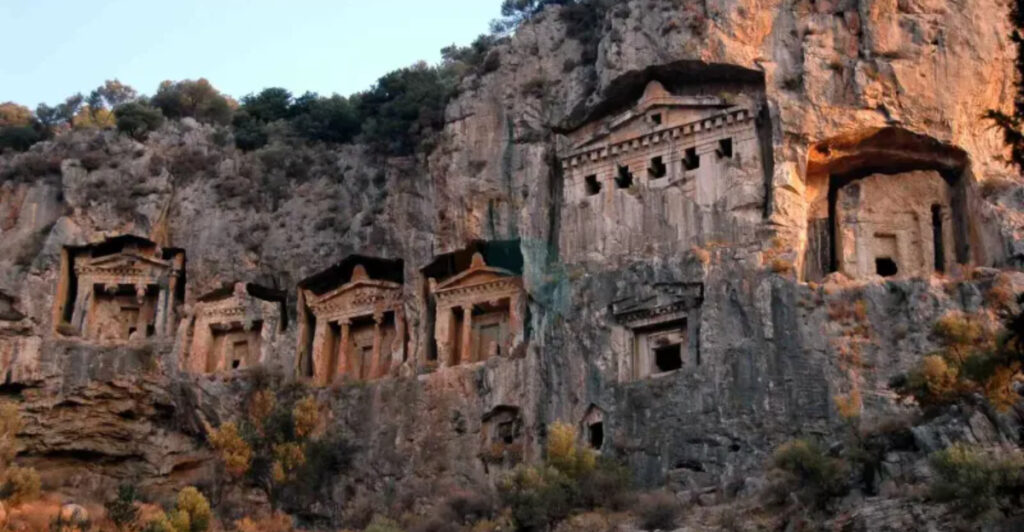Hidden along dramatic cliffs throughout ancient Anatolia, Lycian tomb cities stand as silent testimonies to a civilization that honored its dead through spectacular rock-cut architecture. These gravity-defying necropolises—carved directly into vertical rock faces—represent some of archaeology’s most breathtaking achievements. Suspended between earth and sky, these ancient burial sites offer rare glimpses into beliefs about death, status, and the afterlife that shaped Lycian culture.
Myra’s Twin Necropolises
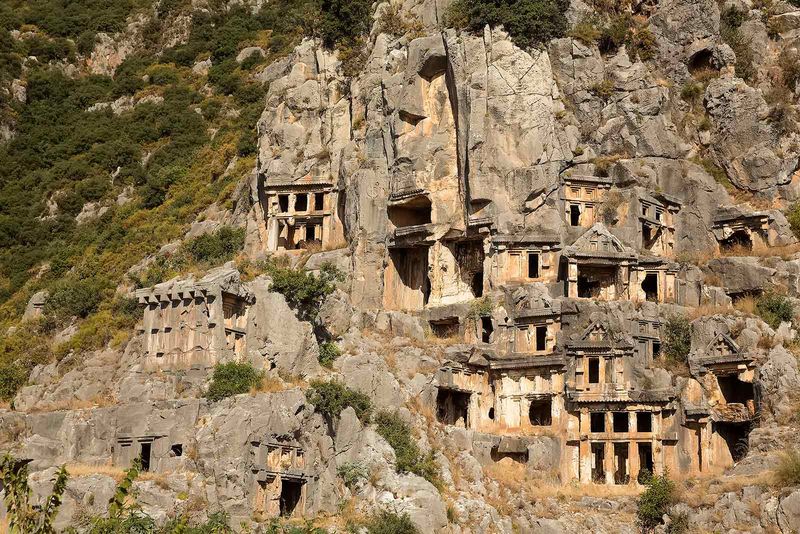
Carved into steep limestone cliffs above an ancient theater, Myra’s river and ocean necropolises showcase the pinnacle of Lycian tomb artistry. The temple-like facades, dating to the 4th century BCE, once dazzled with vibrant red, blue, and yellow pigments that have largely faded over millennia.
Most remarkable is the ‘Lion’s Tomb,’ featuring intricate relief carvings of hunting scenes and mythological figures that speak to Lycian aristocratic values. Visitors often miss the weathered inscriptions in Lycian script that name the tomb occupants.
Standing beneath these looming facades, you can’t help but feel the weight of history—how these eternal houses were deliberately positioned to catch the golden light of sunset, perhaps symbolizing the journey to the afterlife.
Dalyan’s River-Facing Sentinels

Approaching by boat offers the most spectacular view of Dalyan’s cliff tombs. Six magnificent temple-fronted chambers watch eternally over the reed-lined Dalyan River, their reflections dancing on the water’s surface during calm mornings.
Unlike many Lycian sites, these tombs benefit from their riverside setting, which has preserved their intricate details from excessive weathering. Local guides point out how the facades mimic wooden architecture—a fascinating translation of timber construction techniques into permanent stone.
Ancient Caunians believed water spirits would protect their dead, explaining the strategic riverside placement. Modern visitors often report feeling a profound connection to the past when viewing these tombs at sunset, when the golden light transforms the limestone to warm amber.
Fethiye’s Tomb of Amyntas
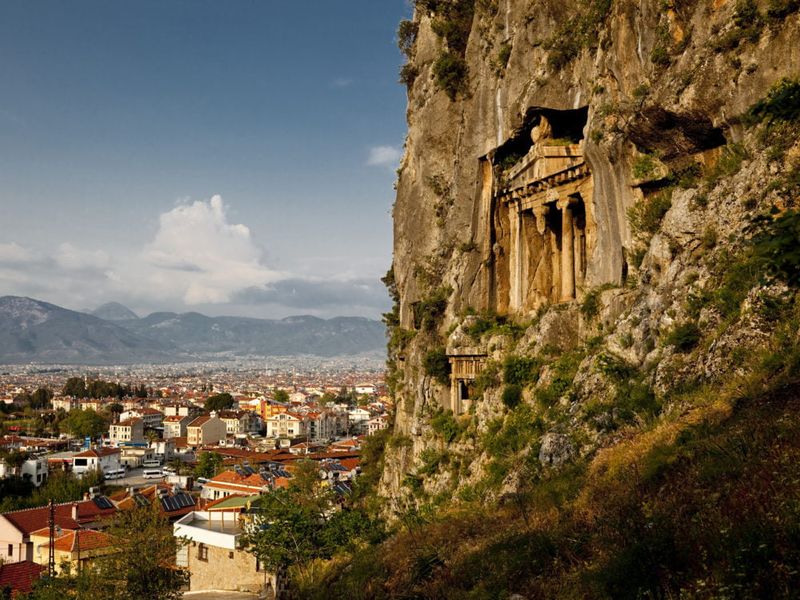
Commanding attention high above modern Fethiye sits the majestic Tomb of Amyntas, perhaps the most perfectly preserved temple-facade tomb in all of Lycia. Carved around 350 BCE, its imposing Ionic columns and detailed pediment demonstrate Greek architectural influence on Lycian burial customs.
The Greek inscription above the doorway reads ‘Amyntou tou Ermagiou,’ indicating this grand resting place belonged to ‘Amyntas, son of Hermagios.’ Unlike many communal necropolises, this singular tomb stands apart, suggesting its occupant held exceptional status.
Local children once played hide-and-seek among the smaller surrounding tombs before conservation efforts restricted access. Reaching the tomb requires climbing steep steps cut into the hillside, a journey that rewards visitors with panoramic views across Fethiye’s harbor.
Tlos: Acropolis of the Dead
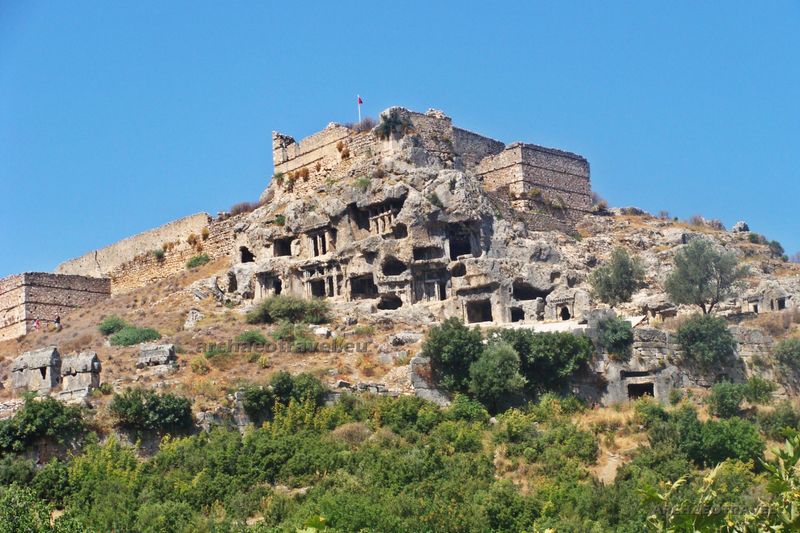
Perched dramatically atop a rocky outcrop, Tlos combines a fortress, city ruins, and an extraordinary necropolis into one awe-inspiring site. The cliff-face tombs here literally crown the ancient city, reinforcing the Lycian belief that the dead should occupy elevated positions.
Most famous among these is the so-called ‘Tomb of Bellerophon,’ featuring a relief carving of the mythical hero mounted on Pegasus. Archaeological evidence suggests Tlos remained continuously inhabited for nearly 4,000 years, making it one of Anatolia’s oldest settlements.
From these lofty tombs, the deceased could forever gaze across the fertile Xanthos Valley they once farmed. Modern excavations have uncovered surprising evidence of tomb reuse across centuries, with Roman-era artifacts found within distinctly Lycian burial chambers.
Xanthos Valley’s Hanging Tombs

Once the proud capital of Lycia, Xanthos harbors some of the most historically significant cliff tombs in the region. Unlike purely decorative facades elsewhere, many Xanthos tombs feature lengthy inscriptions in both Lycian and Greek, providing rare bilingual records that helped scholars crack the Lycian language code.
The famed ‘Harpy Tomb’ exemplifies how these monuments blended practical burial needs with symbolic storytelling. Its relief panels depict winged creatures—possibly sirens rather than harpies—carrying away the souls of the deceased, visualizing Lycian afterlife beliefs.
French archaeologists in the 1800s removed many sculptural elements to the British Museum, sparking ongoing repatriation debates. Today, visitors can still marvel at the engineering precision that allowed these tombs to survive earthquakes that toppled many ground-level structures.
Pinara’s Honeycomb Cliffs
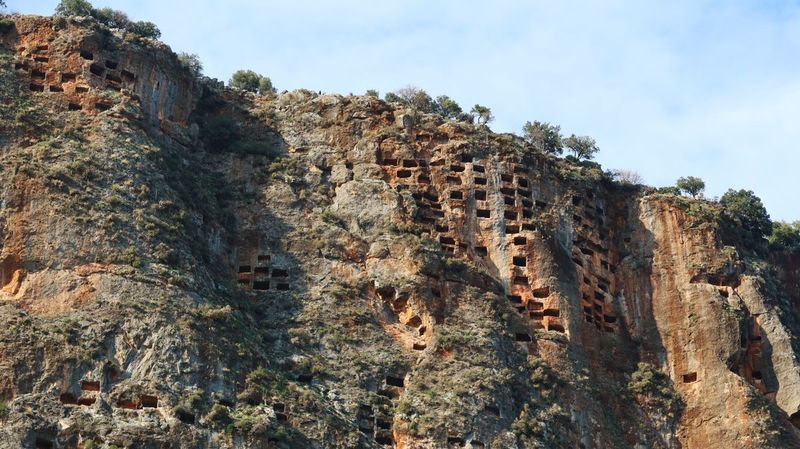
Approaching Pinara reveals an astonishing sight—over 900 rock-cut tombs peppering the reddish cliffs like a honeycomb for the dead. Unlike the grand temple tombs of other sites, Pinara’s necropolis includes hundreds of modest square-cut chambers alongside a smaller number of elaborate facades.
This remarkable density suggests Pinara maintained its importance as a burial center for centuries. The site’s remote location amid pine forests has kept mass tourism at bay, allowing visitors a more intimate connection with these ancient monuments.
Locals share stories of mysterious lights sometimes seen among the tombs at night, attributed to guardian spirits of the Lycian dead. Archaeologists have documented how many tombs incorporate natural rock features—cracks and hollows—suggesting the Lycians viewed these cliffs as naturally sacred spaces.
Patara’s Harbor Sentinels
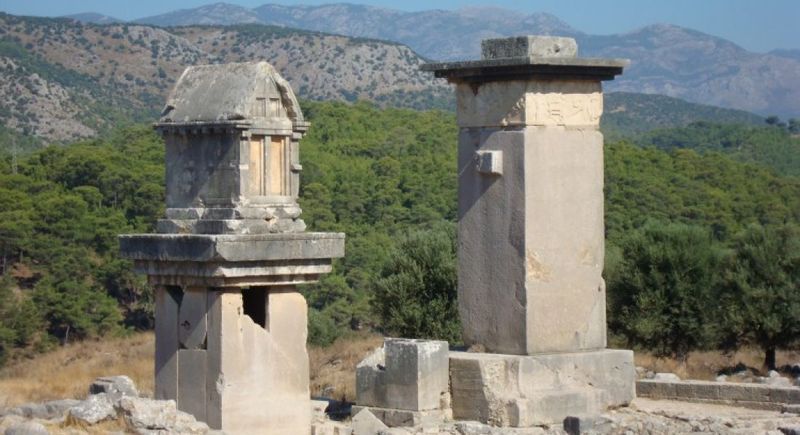
Ancient mariners approaching Patara’s bustling harbor were greeted by tomb facades watching from surrounding hills—silent reminders of mortality amid commercial activity. As Lycia’s primary port, Patara’s necropolis reflects a cosmopolitan influence, with Egyptian and Rhodian stylistic elements mingling with traditional Lycian designs.
Unlike strictly cliff-cut sites, Patara features both rock-hewn chambers and free-standing sarcophagi with distinctive peaked lids resembling upturned boats. This naval connection wasn’t coincidental—many tomb inscriptions honor sea captains and merchants who brought prosperity to the city.
Recent excavations have uncovered surprising evidence of flower offerings at these tombs well into the Byzantine period, suggesting reverence for ancestral burial sites transcended religious changes. Today, visitors can walk the Lycian Way hiking trail directly past these tombs, connecting with ancient pathways.
Olympos: Tombs Amid the Flames
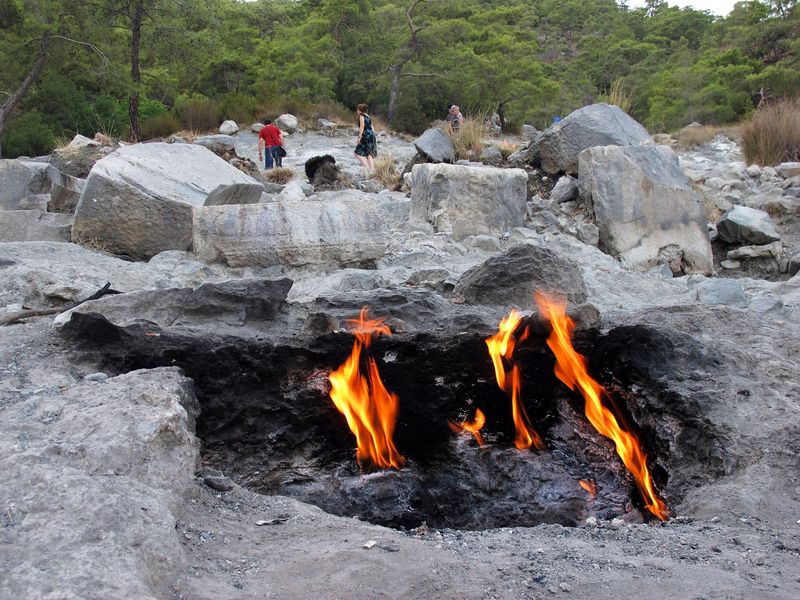
Nestled in a valley where natural eternal flames (the Chimaera) emerge from the earth, Olympos features cliff tombs with a uniquely mystical setting. Ancient Lycians deliberately positioned these burial chambers within sight of these natural gas flares, creating a powerful symbolic connection between death and eternal fire.
Pirates later repurposed many tombs as lookout points and treasure caches during Olympos’s decline in the 3rd century CE. The unusual proximity of tombs to the ancient city center suggests Olympos held different beliefs about the separation of dead and living compared to other Lycian settlements.
The lush vegetation now partially engulfing the site creates an atmosphere straight from adventure tales, with tree roots embracing ancient stone. Rock climbers occasionally spot previously undocumented tomb entrances high on inaccessible cliff faces, suggesting the necropolis may be even larger than currently mapped.
Phaselis: Crimson Cliff Chambers

Overlooking three separate harbors, Phaselis’s lesser-known necropolis features tombs carved into distinctive reddish-hued cliffs. These burial chambers allowed the deceased to eternally watch over maritime activities that brought the city its wealth and prominence.
Unlike the temple facades common elsewhere, many Phaselis tombs display simple rectangular entrances with subtle architectural details. What makes them remarkable is their strategic placement—positioned to catch the first rays of morning sunlight and the last golden glow of sunset.
Marine archaeologists have discovered votive offerings of miniature boats in several chambers, suggesting occupants maintained connections to seafaring. The site offers a rare opportunity to see tombs in their original unrestored state, with minimal tourist infrastructure allowing a more authentic connection to how ancient visitors would have experienced these monuments.
Myra’s Painted Legacy

Early European explorers to Myra documented what modern visitors can barely imagine—tomb facades ablaze with brilliant pigments. Watercolor sketches from the 1840s reveal vibrant blues, reds, and yellows adorning architectural details and relief carvings, transforming stone into colorful eternal homes.
Particularly moving are the preserved inscriptions, including poignant messages like ‘Moschos loves Philiste,’ humanizing these ancient monuments. Chemical analysis of paint traces confirms Lycians used expensive imported pigments, indicating these tombs represented enormous financial investments for families.
The fading of these colors represents an immense archaeological loss, though modern lighting techniques occasionally reveal ghost images of patterns invisible to the naked eye. Archaeologists debate whether to attempt color reconstructions at select tombs, balancing authentic presentation against helping visitors understand their original appearance.
The Harpy Tomb’s Widespread Influence
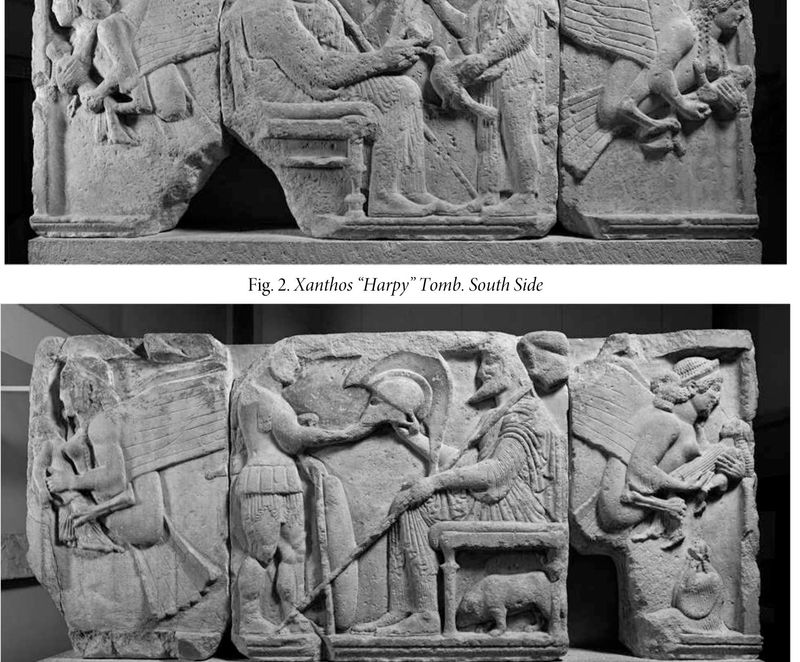
Though physically located in Xanthos, the iconic Harpy Tomb established artistic standards that spread throughout Lycia’s cliff necropolises. Its revolutionary frieze—depicting winged creatures transporting souls to the afterlife—inspired similar imagery at sites including Myra, Tlos, and Pinara.
Beyond mythology, the tomb introduced architectural innovations like relief panels set within structural frames. Careful examination reveals how artisans across Lycia adapted these elements to local tastes and materials.
Pomegranate symbols, representing fertility and rebirth, appear frequently in tombs influenced by this masterwork. Archaeological evidence suggests specialized carving workshops traveled between sites, explaining stylistic similarities despite geographical distances. Modern visitors can trace this artistic lineage by noting recurring motifs across different necropolises—a visual conversation spanning centuries.
Skyward Souls: The Elevation Mystery
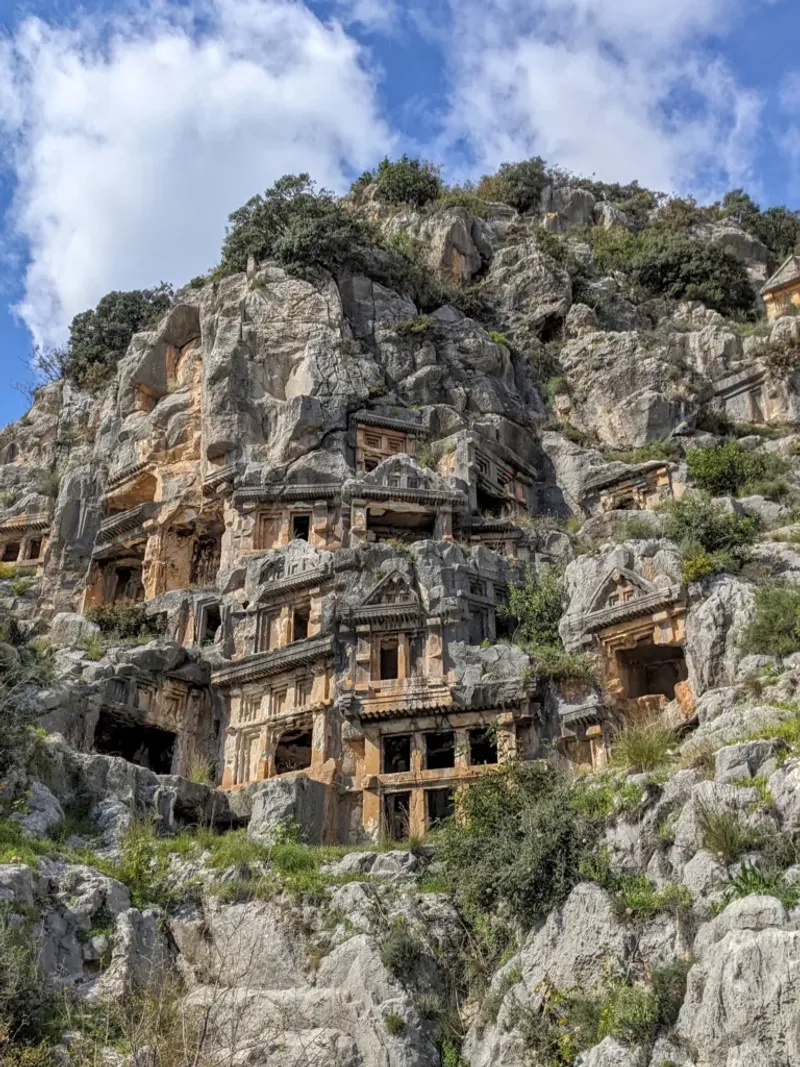
Why did Lycians consistently place their dead so high above the living? This archaeological puzzle centers on the remarkable preference for creating tombs at seemingly impossible heights.
Some scholars point to practical concerns—elevated positions protected remains from flooding and wild animals. Yet religious texts suggest deeper symbolism, potentially connecting to beliefs about souls ascending to join sky deities.
Recent research proposes these positions may have served astronomical purposes, with certain tomb entrances aligning with solstice sunrises or star positions. Climbers who have reached higher tombs report finding unexpected features not visible from below, including small channels potentially used for liquid offerings. The extraordinary engineering required—carving precise chambers without modern scaffolding—remains one of ancient Lycia’s most impressive and mysterious achievements.
The Lycian Way: Trail of the Ancients

Modern adventurers can experience multiple cliff necropolises via Turkey’s 540-kilometer Lycian Way hiking trail. This marked path—connecting ancient Lycia’s major settlements—passes directly beneath towering tomb facades at Myra, skirts the harbor necropolis at Patara, and offers panoramic views of Tlos’s acropolis burials.
Following ancient trade routes, the trail provides context often missing from isolated site visits. Hikers gain appreciation for how these monuments related to natural landscapes and settlement patterns.
Spring trekkers enjoy the added magic of wildflowers blooming among ruins, sometimes including species depicted in tomb carvings 2,000 years ago. Local guides share stories of tomb guardians and ancient Lycian death rituals passed through generations. This immersive journey offers something site-hopping by car cannot—experiencing these monuments as ancient Lycians would have, on foot through mountains and coastal paths.

